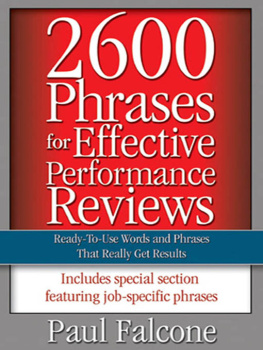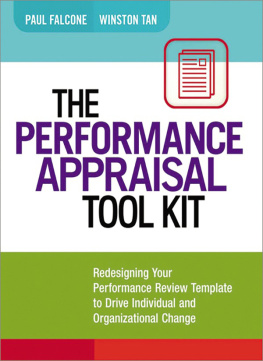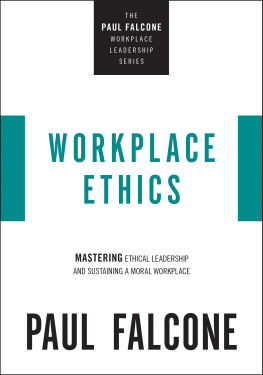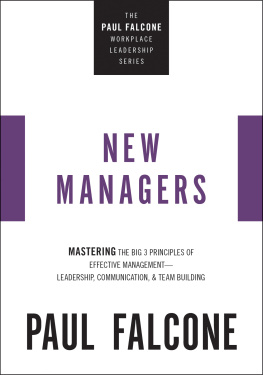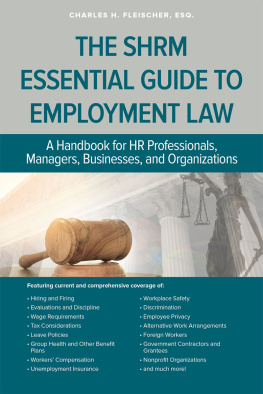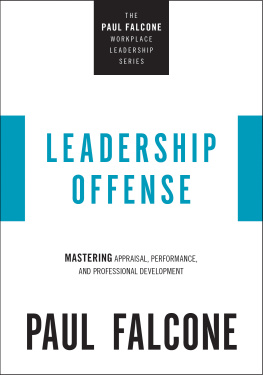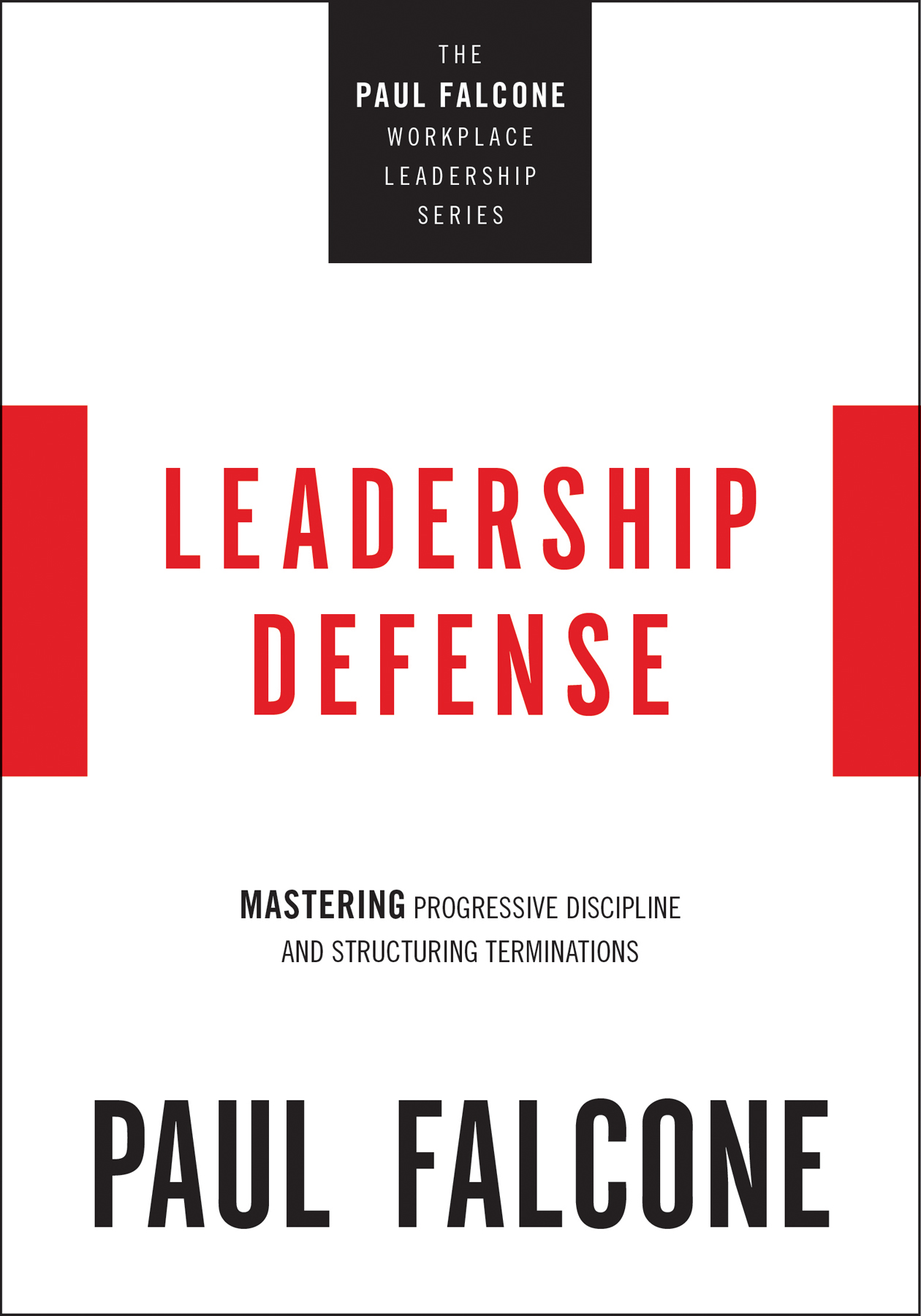2022 Paul Falcone
All rights reserved. No portion of this book may be reproduced, stored in a retrieval system, or transmitted in any form or by any meanselectronic, mechanical, photocopy, recording, scanning, or otherexcept for brief quotations in critical reviews or articles, without the prior written permission of the publisher.
Published by HarperCollins Leadership, an imprint of HarperCollins Focus LLC.
Published in association with Kevin Anderson & Associates: https://www.ka-writing.com/.
Topic 5: From Beyond Harassment 101: Opening Culture-Change Discussions with Your Team. SHRM HR Daily Newsletter, July 30, 2019. Copyright 2019 by the Society for Human Resource Management. Topic 7: From Team Angst and Brokering Peace in the COVID-19 Era. SHRM HR Daily Newsletter, July 7, 2020. Copyright 2020 by the Society for Human Resource Management. Topic 8: From Rumor Mongers and Gossipers: How to Stop Stirring the Pot. SHRM HR Daily Newsletter, October 13, 2019. Copyright 2021 by the Society for Human Resource Management. Topic 14: From When Documenting, Beware: Missteps Can Sink Your Ship in Court. SHRM HR Daily Newsletter, August 29, 2016. Copyright 2016 by the Society for Human Resource Management. Topic 21: From Vetting the Record Before Recommending Termination. SHRM HR Daily Newsletter, March 2, 2021. Copyright 2021 by the Society for Human Resource Management. Topic 25: From Handling Employees Who QuitThen Change Their Minds. SHRM HR Daily Newsletter, December 13, 2019. Copyright 2019 by the Society for Human Resource Management. Topic 26: From If I Cant Fire Someone, Can I Lay Him Off Instead? SHRM HR Daily Newsletter, March 4, 2020. Copyright 2020 by the Society for Human Resource Management. All of the above used by permission of the publisher. All rights reserved.
Any internet addresses, phone numbers, or company or product information printed in this book are offered as a resource and are not intended in any way to be or to imply an endorsement by HarperCollins Leadership, nor does HarperCollins Leadership vouch for the existence, content, or services of these sites, phone numbers, companies, or products beyond the life of this book.
This book is written as a source of information only. The information contained in this book should by no means be considered a substitute for the advice, decisions, or judgment of the readers professional advisors.
All efforts have been made to ensure the accuracy of the information contained in this book as of the date published. The author and the publisher expressly disclaim responsibility for any adverse effects arising from the use or application of the information contained herein.
ISBN 978-1-4002-3013-6 (eBook)
ISBN 978-1-4002-3005-1 (TP)
Epub Edition December 2021 9781400230136
Library of Congress Control Number: 2021951252
Printed in the United States of America
22 23 24 25 26 LSC 10 9 8 7 6 5 4 3 2 1
Ebook Instructions
In this ebook edition, please use your devices note-taking function to record your thoughts wherever you see the bracketed instructions [Your Notes] Use your devices highlighting function to record your response whenever you are asked to checkmark, circle, underline, or otherwise indicate your answer(s).
CONTENTS
Guide
Leadership defense is a topic that sometimes gets short shrift because more attention is paid to motivating and inspiring employees so they experience satisfaction and engagement in the workplace. That positive outlook is so important, but equally important is disciplining and terminating problematic employees, because its a rare organization that has only exceptional employees.
As much as we may think we hire the best and brightest, we cant really know whats in their hearts. And although thorough interview rounds, preemployment testing, criminal background checks, and reference checks all play critical roles in making high-probability hires, theres still no guarantee that all who join your team will have altruistic and selfless motives to help you as their leader and the company overall to grow and thrive.
Of course, not all problematic workers come from external hires. Managers sometimes inherit problematic performers via internal transfers or layoffs in other departments, and sometimes entitlement mentalities and victim syndromes simply develop on their own among legacy employees.
In short, any employee at any given time may be facing severe personal problems or simply dislike working in your group or with certain members of your team. Or a successful worker from another department may resent the new challenges your department presents or have difficulty getting over past hurts or current perceived indignities.
However such problems find their way into the workplace, youll no doubt be required to deal with them at some point in your career. The goal isnt to judge anyone; its simply to observe the situation and then remedy it professionally and respectfully. But if anyone refuses to reinvent themselves and their relationship to you and the rest of your team, then the leadership defense strategies discussed in this book should help you address the situation constructively and directly.
This book focuses on concrete, hard-core, practical leadership land mines that may await even the most well-meaning or otherwise successful managers. Be sure to rely on these guiding principles so you dont get caught in a snare you didnt see coming. This isnt meant to make you paranoid; instead, its meant to raise your awareness, so you come to rely more fully on your gut, intuition, or sixth sense. You need to make sure you know how to follow these internal pulses when they tell you that something may be going wrong. Equally important, you need to know when, how, and to whom to disclose your concerns so that you build successful alliances within your company and create the proper record when problematic employee performance or conduct may occur in your group. Mastering these best practices in leadership defense strategies will help protect both you and your company.
DISCLAIMER
Note: Throughout this book, I interchange the use of his and her, and I provide examples of fictitious men and women. Obviously, all situations described in these pages can apply to anyone. Further, please bear in mind at all times that this book is not intended as a legal guide to the complex issues surrounding progressive discipline, termination, and other aspects of your employment practices. Because the book does not purport to render legal advice, it should not be used in place of a licensed practicing attorney when proper legal counsel and guidance become necessary. You must rely on your attorney to render a legal opinion that is related to actual fact situations.
T his section shows how to handle some of the most common and challenging problems that arise in many workplaces: poor attitudes, bullying, swearing, harassment (especially sexual harassment), gossip, rumormongers, snitches, even body odor. Ill describe how to have tough conversations with people about these problems, how to hold employees accountable for their behavior, how to mediate disputes among workers, how to avoid off-the-record conversations, and how to confront problems head-on, because avoiding them is not the best approach!
O ne of the most common challenges facing managers is dealing with employee attitude problems, typically evidenced when employees roll their eyes, sigh, and use antagonistic body language. Trying to stop such silent behavior is difficult because employees can so easily deny it.


